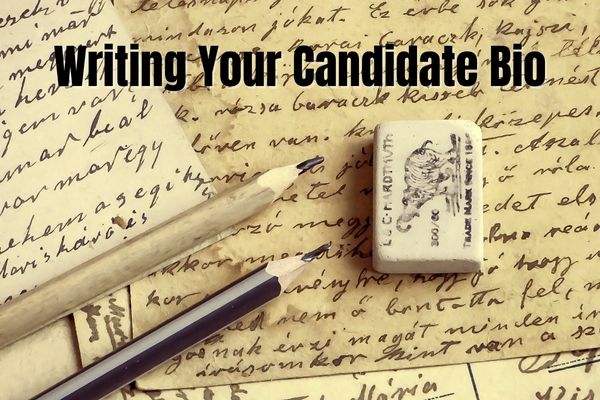A candidate biography is a short, comprehensive summary of a candidate’s life. A good school board candidate biography showcases your educational leadership and provides voters with an overview of who you are, your leadership in educational initiatives, why you are running, and why voters should support you.
Your biography should include basic information about your education, professional background, and any volunteer work that you’ve done, particularly if that work has to do with school governance or the school district. Highlight information about relevant skills that you’ll bring to job when elected to the board.
Tips for writing an electable school board candidate bio:
- Keep it short, concise, and reflect your commitment to educational excellence.
- Include your unique qualifications and experience.
- Share your goals and vision for the future of education in your district.
- Let voters know what you stand for and what you will do to as a member of the school board.
- Remind them to support or vote for you on election day!
Find an interesting hook
Try to find a hook in your story that relates to your child as a student or schools in general. Use that hook in your introduction. It should be intriguing and make the reader understand your motivations for wanting to serve on the local school board.
An example of a motivational hook could be: “I am running for school board because my child had special educational needs that were not addressed by the district. I know there are other students that need special help, and I intend to help them get it.”
Include your education and expertise
Your bio for school board should include basic information about your education, professional background, and any volunteer work that you’ve done, particularly if that work has to do with schools or the school district.
Highlight your specific experiences and achievements in education or related fields. Mention any roles, projects, or accomplishments that showcase your leadership, problem-solving skills, and knowledge of educational systems.
Example: “During my tenure on the local education committee, I spearheaded a campaign for better STEM resources, significantly improving our district’s science and technology curriculum.”
Share your vision and goals
In your bio, clearly articulate your vision for education in your district. Consider the future you see for students and teachers. Be specific. For instance, if your goal is to integrate more technology in classrooms, mention it. Or, if you wish to enhance arts education, highlight this. Your candidate statement should address the unique needs and issues that face your district. Voters should understand what changes your goals and priorities will make.
Most candidate information is generally written in the third person. You want a third-person version for your website and campaign brochures. When addressing others, of course, you’ll want to refer to yourself in the first person.
Here’s an example of a board of education bio:
Elaine Johnson: Advocate for Educational Innovation
Elaine Johnson is a dedicated leader in education administration and will bring a fresh perspective to our local school board. With extensive experience in education administration, Elaine’s commitment to academic excellence and community engagement sets her apart.
A Personal Connection with Education
Elaine’s interest in education began with her family. Several of her family members, including her mother and aunt, were educators. This background gave her a unique insight into the education system.
Elaine earned her degree in teaching degree and Masters in Education from Upstate University. Her career in education spans over fifteen years. She has a track record of implementing effective educational programs, including revolutionary STEM programs for juniors and seniors. While serving as the Ridgefield elementary school principal, she worked with the state on innovative educational programs. She increased student and parent involvement through the PTA.
Engaged in our Community
Even beyond the school walls, Elaine has always been deeply involved in our community. She joined the boards of several educational foundations. In this role, she pushed equal access to education and collaborated with youth organizations. These partnerships have enriched students’ educational experiences both in the classroom and beyond.
Vision and Goals for our Schools
Elaine’s vision is to bring innovative solutions to the school board. Her focus is on creating a challenging and supportive classroom environment. Rather than waiting for student welfare problems to grow, she believes that the school board should be proactive in problem-solving.
Let’s Improve our District!
Support Elaine Johnson in her quest for educational improvement. Vote for Elaine in the school board election this November. Help improve our children’s education.
Proofread your candidate statement
Before you release your bio, have other people you trust read your the draft and provide feedback. Use online tools like Grammarly to make sure everything is correct with the spelling and grammar. After all, if you are running for a position that deals with education, you need to be able write well!
What’s your elevator pitch?
Now that you have written a full candidate biography, it’s time to break it down.
Once you have written your full candidate biography, you should create a more concise version. This is called an ‘elevator pitch’, which is a short description of yourself that explains who you are and why you are running for office. It should be something that can be explained in just 20 to 30 seconds. Memorize this pitch, as there will be many opportunities to use it when you meet individuals or speak to groups.
You can also take written sections of your bio and rework them for use in other campaign materials. Incorporate elements of your bio into public presentations and speeches.
In conclusion
Your personal bio is an important part of successful campaign branding, so it’s important to take the time to write it with detail and enthusiasm!




